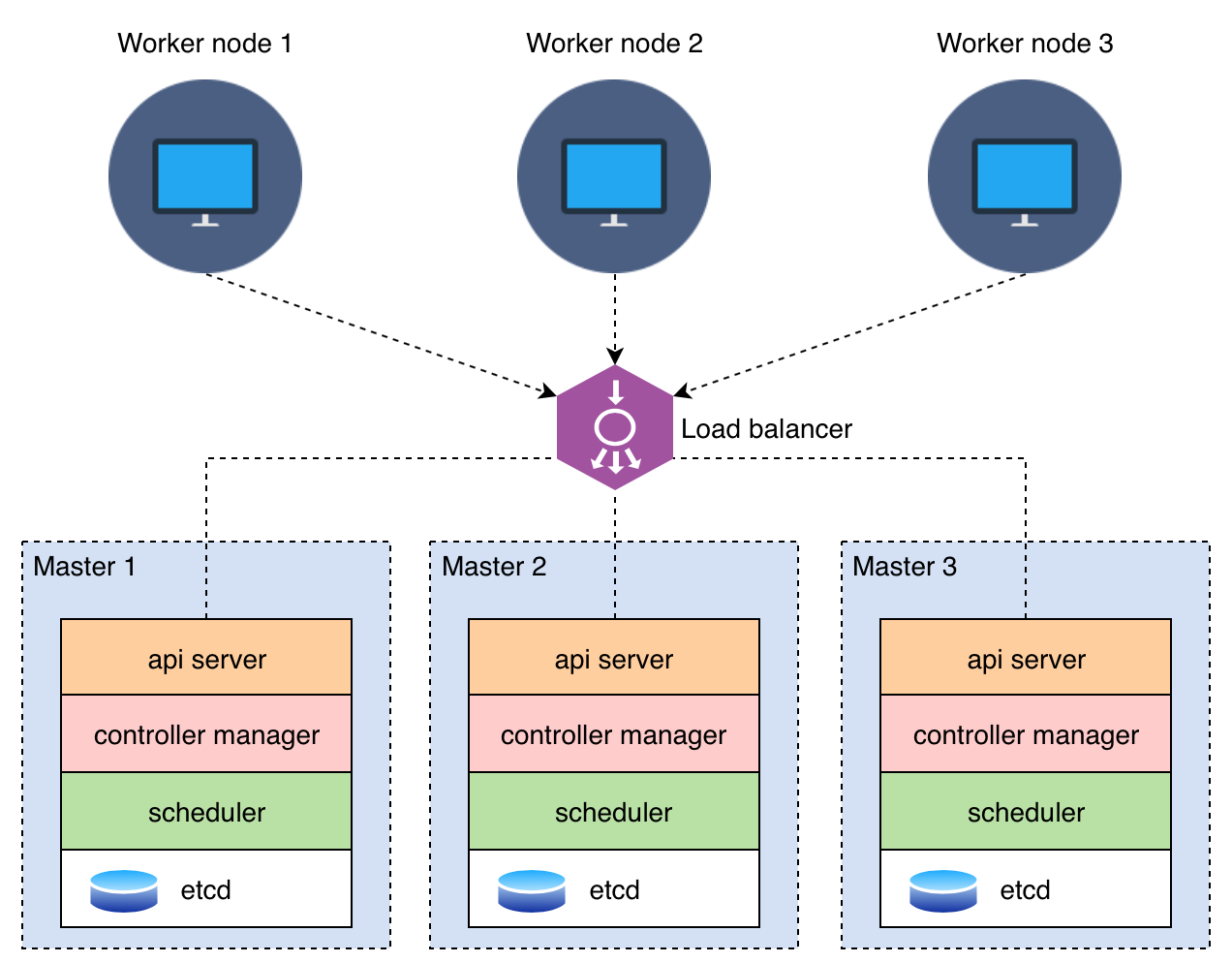kubeadm is a tool which is a part of the Kubernetes project. It helps you deploy a Kubernetes cluster. This article will show you the way to upgrade a Highly Available Kubernetes cluster from v1.13.5 to v1.14.0
Contents:
1. Deploying multi-master nodes (High Availability) K8S
2. Upgrading the first control plane node (Master 1)
3. Upgrading additional control plane nodes (Master 2 and Master 3)
4. Upgrading worker nodes (worker 1, worker 2 and worker 3)
5. Verify the status of cluster
1. Deploying multi-master nodes (High Availability) K8S
Following this tutorial guide to setup cluster.
The bare-metal server runs Ubuntu Server 16.04 and there are 7 Virtual Machine (VMs) will be installed on it. Both of the VMs also run Ubuntu Server 16.04.
- 3 master nodes
- 3 worker nodes
- 1 HAproxy load balancer

The stacked etcd cluster
The result:
master1@k8s-master1:~$ sudo kubectl get node
NAME STATUS ROLES AGE VERSION
k8s-master1 Ready master 20h v1.13.5
k8s-master2 Ready master 19h v1.13.5
k8s-master3 Ready master 19h v1.13.5
k8s-worker1 Ready <none> 19h v1.13.5
k8s-worker2 Ready <none> 19h v1.13.5
k8s-worker3 Ready <none> 19h v1.13.5
2. Upgrading the first control plane node (Master 1)
2.1. Find the version to upgrade to
sudo apt update
sudo apt-cache policy kubeadm
2.2. Upgrade the control plane (master) node
sudo apt-mark unhold kubeadm
sudo apt update && sudo apt upgrade
sudo apt-get install kubeadm=1.14.0-00
sudo apt-mark hold kubeadm
2.3. Verify that the download works and has the expected version
sudo kubeadm version
2.4. Modify configmap/kubeadm-config for this control plane node and remove the etcd section completely
sudo kubectl edit configmap -n kube-system kubeadm-config
# Please edit the object below. Lines beginning with a '#' will be ignored,
# and an empty file will abort the edit. If an error occurs while saving this file will be
# reopened with the relevant failures.
#
apiVersion: v1
data:
ClusterConfiguration: |
apiServer:
certSANs:
- 10.164.178.238
extraArgs:
authorization-mode: Node,RBAC
timeoutForControlPlane: 4m0s
apiVersion: kubeadm.k8s.io/v1beta1
certificatesDir: /etc/kubernetes/pki
clusterName: kubernetes
controlPlaneEndpoint: 10.164.178.238:6443
controllerManager: {}
dns:
type: CoreDNS
etcd:
local:
dataDir: /var/lib/etcd
imageRepository: k8s.gcr.io
kind: ClusterConfiguration
kubernetesVersion: v1.14.0
networking:
dnsDomain: cluster.local
podSubnet: ""
serviceSubnet: 10.96.0.0/12
scheduler: {}
ClusterStatus: |
apiEndpoints:
k8s-master1:
advertiseAddress: 10.164.178.161
bindPort: 6443
k8s-master2:
advertiseAddress: 10.164.178.162
bindPort: 6443
k8s-master3:
advertiseAddress: 10.164.178.163
bindPort: 6443
apiVersion: kubeadm.k8s.io/v1beta1
kind: ClusterStatus
kind: ConfigMap
metadata:
creationTimestamp: "2019-05-21T10:08:03Z"
name: kubeadm-config
namespace: kube-system
resourceVersion: "209870"
selfLink: /api/v1/namespaces/kube-system/configmaps/kubeadm-config
uid: 52419642-7bb0-11e9-8a89-0800270fde1d
2.5. Upgrade the kubelet and kubectl
sudo apt-mark unhold kubelet
sudo apt-get install kubelet=1.14.0-00 kubectl=1.14.0-00
sudo systemctl restart kubelet
2.6. Start the upgrade
sudo kubeadm upgrade apply v1.14.0
Logs of the upgrading process can be found here.
3. Upgrading additional control plane nodes (Master 2 and Master 3)
3.1. Find the version to upgrade to
sudo apt update
sudo apt-cache policy kubeadm
3.2. Upgrade kubeadm
sudo apt-mark unhold kubeadm
sudo apt update && sudo apt upgrade
sudo apt-get install kubeadm=1.14.0-00
sudo apt-mark hold kubeadm
3.3. Verify that the download works and has the expected version
sudo kubeadm version
3.4. Upgrade the kubelet and kubectl
sudo apt-mark unhold kubelet
sudo apt-get install kubelet=1.14.0-00 kubectl=1.14.0-00
sudo systemctl restart kubelet
3.5. Start the upgrade
master2@k8s-master2:~$ sudo kubeadm upgrade node experimental-control-plane
master3@k8s-master3:~$ sudo kubeadm upgrade node experimental-control-plane
Logs when upgrading master 2: log-master2
Logs when upgrading master 3: log-master3
4. Upgrading worker nodes (worker 1, worker 2 and worker 3)
4.1. Upgrade kubeadm on all worker nodes
sudo apt-mark unhold kubeadm
sudo apt update && sudo apt upgrade
sudo apt-get install kubeadm=1.14.0-00
sudo apt-mark hold kubeadm
4.2. Cordon the worker node, on the Master node, run:
sudo kubectl drain $WORKERNODE --ignore-daemonsets
4.3. Upgrade the kubelet config on worker nodes
sudo kubeadm upgrade node config --kubelet-version v1.14.0
4.4. Upgrade kubelet and kubectl
sudo apt update && sudo apt upgrade
sudo apt-get install kubelet=1.14.0-00 kubectl=1.14.0-00
sudo systemctl restart kubelet
4.5. Uncordon the worker nodes, bring the node back online by marking it schedulable
sudo kubectl uncordon $WORKERNODE
5. Verify the status of cluster
master1@k8s-master1:~$ sudo kubectl get node
NAME STATUS ROLES AGE VERSION
k8s-master1 Ready master 21h v1.14.0
k8s-master2 Ready master 21h v1.14.0
k8s-master3 Ready master 21h v1.14.0
k8s-worker1 Ready <none> 20h v1.14.0
k8s-worker2 Ready <none> 20h v1.14.0
k8s-worker3 Ready <none> 20h v1.14.0
6. References
[1] https://kubernetes.io/docs/tasks/administer-cluster/kubeadm/kubeadm-upgrade-ha-1-13/
[2] https://kubernetes.io/docs/tasks/administer-cluster/kubeadm/kubeadm-upgrade-1-14/
[3] https://github.com/truongnh1992/upgrade-kubeadm-cluster
Author: truongnh1992 - Email: nguyenhaitruonghp[at]gmail[dot]com
